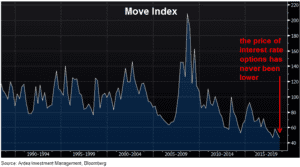Volatility strategies are reliable risk diversifiers
The large and liquid universe of global interest rate options offers a great set of tools from which volatility strategies can be constructed. Such strategies generate profits from large interest rate moves, irrespective of their direction, which is what makes them very reliable risk diversifiers that can protect investment portfolios from capital losses.
For example, a large move lower in rates would occur in a recession scenario and a large move higher in rates would accompany an inflation break out that forces central banks to hike rates aggressively. Both scenarios would be negative for equities and credit investments, while the latter would also be negative for government bonds.
So, these volatility strategies can be used for reliable protection in scenarios where conventional equity, credit and government bond investments all get hit at the same time.
These trades can be structured to provide more efficient protection than simply buying put options, which means they provide protection when needed, without imposing an onerous return drag in benign market environments.
And right now, it’s cheaper than ever to implement them.
A particularly powerful combination is incorporating volatility strategies into a broader non-directional fixed income relative value portfolio. This is because volatility can and does stay low for long periods of time, punctuated by short sharp bursts as in February this year. A standalone volatility strategy can struggle to survive through these benign periods, long enough to take advantage of the volatility burst when it happens.
Having a strategy that can access a broad range of uncorrelated relative value return sources, in addition to volatility based strategies, provides the risk balance that allows the portfolio to generate reliable returns during the long benign periods, while still being able to take advantage of the volatility bursts when they happen.
In financial markets uncertainty is always present, it’s just the degree that varies. Faced with the risks posed by trade wars, emerging market instability, China’s economic slowdown, renewed concerns about Italy, the prospect of a messy Brexit and the US Federal Reserve’s shift to exit from unprecedented monetary stimulus … it’s fair to say uncertainty is currently at the higher end of the spectrum.
What is jarringly at odds with this observation is that volatility implied by pricing in various option markets has dropped to near record low levels.
Much has been written to explain this abnormally low market pricing of volatility. The more widely cited possibilities include the ‘goldilocks’ economic environment, the rise of passive investing and extreme monetary policy forcing yield seekers to boost returns by selling options.
But perhaps it’s just that low volatility begets low volatility. This sort of self-reinforcing feedback loop results in option sellers, emboldened by the recent history of low volatility, being enticed into selling more options, which in turn reduces volatility further and generates profits for their ‘short volatility’ strategies, in turn triggering yet more option selling. This dynamic typically works and works and works … until it doesn’t … as in February this year.
To understand this, behavioural finance studies of ‘recency bias’ are useful. They find that investors tend to overemphasise the importance of the most recent information at the expense of using broader data sets that would yield more balanced analysis. The evidence strongly suggests that decisions skewed by recency bias usually don’t turn out well.
And indeed, current levels of option prices have become anchored to the recent history of benign market conditions, rather than reflecting the future uncertainty they are supposed to and the chart below shows the end result when extreme reach for yield behaviour meets the behavioural bias of ‘recency’. For investors with expertise in option markets, this represents a pricing inefficiency that can be exploited, not just to generate returns but also for defensive portfolio construction.
The chart shows the MOVE Index, which aggregates volatility expectations implied in the pricing of a range of US government bond options.

The best time to buy volatility protection is when it’s cheap, not when markets ‘seem risky’ … but human nature is to do the opposite, which is a source of pricing inefficiency that relative value investors can take advantage of.
Even if volatility continues to decline further, these strategies can be implemented efficiently to avoid compromising returns, particularly when incorporated into a broader relative value fixed income strategy.
Volatility strategies are an underutilised risk management tool that are very effective for fixed income portfolios that prioritise capital preservation and are being used by investors to diversify risk inherent in their other investments.

